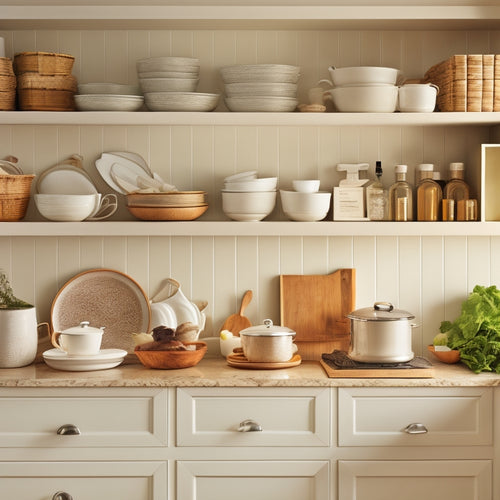
Rent-Friendly Organization Ideas for Small Spaces
Share
You're not alone in the struggle to maximize your small rental space. To start, utilize hanging organizers, wall-mounted storage, and over-door solutions to free up floor space. Next, tap into hidden storage areas like under-bed bins, closet organization systems, and cabinet inserts. Don't forget to choose multi-functional furniture pieces, like ottomans with storage, and consider creative shelving solutions like DIY floating shelves. Finally, declutter to create a more spacious feel and eliminate unnecessary items. By implementing these strategies, you'll be well on your way to a more organized, rent-friendly space - and there's even more to explore.
Key Takeaways
• Utilize wall-mounted storage units and shelves to maximize vertical storage space without damaging walls.
• Opt for multi-functional furniture pieces that serve more than one purpose to save floor space.
• Choose collapsible shelves and storage bins that can be easily set up and taken down for rent-friendly organization.
• Make the most of hidden storage areas like under-bed storage bins, closet organizers, and over-the-door solutions.
• Edit and curate belongings to declutter and minimize storage needs, ensuring a more spacious and organized living area.
Maximizing Vertical Storage Space
You can easily triple your storage capacity by utilizing your walls and ceiling to maximize vertical storage space. This is especially important in small spaces where every inch counts.
One effective way to do this is by using hanging organizers, such as shelves or baskets, that can be attached to your walls or ceiling. These can be used to store items like linens, cleaning supplies, or even bikes.
Another option is collapsible shelves, which can be easily set up and taken down as needed. Wall mounted storage units are also a great option, providing additional storage without taking up valuable floor space.
Over door solutions, like shoe organizers or hooks, can also be used to hang items like jackets, bags, or accessories. By making the most of your vertical space, you can free up floor space and create a more organized and clutter-free living area.
With a little creativity, you can turn your small space into a functional and comfortable home.
Utilizing Hidden Storage Areas
By thinking outside the box and exploring unconventional storage spots, you can uncover hidden areas that can be repurposed to stash away items, keeping your small space organized and clutter-free.
One such area is under your bed, where you can install under-bed storage bins or drawers to store out-of-season clothes, linens, or luggage.
In your closet, consider implementing a closet organization system that includes shelves, bins, and double rods to maximize storage capacity. You can also utilize the space above your closet door by installing shelves or hooks for hanging items like bags, hats, or accessories.
Look for opportunities to add cabinet inserts, such as dividers or turntables, to make the most of your kitchen or bathroom cabinets. Wall-mounted options like shelves, hooks, or baskets can also provide additional storage without taking up valuable floor space.
Space-Saving Furniture Essentials
Frequently, the key to maintaining order in small spaces lies in selecting multi-functional furniture pieces that serve more than one purpose, thereby reducing clutter and optimizing available space.
When it comes to seating, you can opt for compact seating options like ottomans with storage or foldable chairs that can be easily tucked away when not in use. Stylish storage solutions, such as storage cubes or baskets, can also help keep your belongings organized and out of sight.
Functional folding furniture is another great option for small spaces. Folding tables, chairs, and desks can be easily set up and taken down as needed, providing you with the flexibility to use your space in different ways.
Additionally, consider incorporating dual-purpose decor into your space, such as a storage coffee table or a desk with built-in shelving. By choosing furniture that serves multiple purposes, you'll be able to maximize your space and minimize clutter.
With a little creativity, you can create a functional and stylish space that meets your needs.
Creative Shelving Solutions Found
Incorporating creative shelving solutions into your small space design can help maintain the sense of openness and flow you've achieved with multi-functional furniture, while keeping your belongings organized and within reach.
By thinking outside the box (or shelf!), you can create a functional and stylish space that works for you.
Here are some creative shelving ideas to ponder:
-
DIY floating shelves: Add a touch of modernity to your space with DIY floating shelves that appear to be 'floating' on the wall. This is a great way to display decorative items or store books, without taking up valuable floor space.
-
Wall-mounted storage: Maximize your wall space by installing wall-mounted storage units, such as shelves, hooks, or baskets. This will help keep your floors and surfaces clutter-free, while keeping your belongings within easy reach.
-
Adjustable shelving: Invest in adjustable shelving units that can be customized to fit your changing needs. This is especially useful in small spaces where flexibility is key.
Decluttering for a Smaller Footprint
You need to declutter your space to minimize the amount of stuff you have to organize and store in your small space. It's crucial to get rid of items you no longer need, use, or love.
Go through your belongings, and sort them into three piles: keep, donate/sell, and discard. Be honest with yourself – if you haven't used something in a year, it's probably safe to let it go.
Adaptable Room Layout Strategies
When designing an adaptable room layout, you'll want to prioritize flexibility and functionality.
You can achieve this by incorporating flexible furniture arrangements, creating multipurpose zones, and optimizing traffic flow to save space.
Flexible Furniture Arrangements
By swapping fixed pieces for multipurpose ones, your small space can effortlessly transform to accommodate different activities and moods. This flexibility is key to creating a functional and comfortable living area.
With flexible furniture arrangements, you can optimize your space and make the most of its limitations.
For instance, consider using:
- Ottoman storage with a removable top that doubles as a coffee table
- A murphy desk that folds up against the wall when not in use
- A modular sofa with removable cushions that can be rearranged to suit different seating configurations
Multipurpose Zone Creation
Multipurpose zones emerge as a result of strategically dividing your space into adaptable areas that serve multiple functions. By doing so, you'll be able to create a more efficient and functional living space. To achieve this, focus on furniture versatility and decorative partitions. For instance, consider using a room divider to separate your living and working areas, or a storage ottoman that doubles as a coffee table.
Here are some examples of multipurpose zones you can create:
| Zone | Function 1 | Function 2 |
|---|---|---|
| Living Room | Relaxation | Entertainment |
| Home Office | Work | Study |
| Dining Area | Meals | Socializing |
| Storage Nook | Storage | Display |
Space-Saving Traffic Flow
To maximize the functionality of your multipurpose zones, you'll want to assess the flow of traffic in your space and strategically design your room layout to accommodate it. This is vital in small spaces, where clutter and poor layout can make a room feel cramped and overwhelming.
By creating an efficient room flow, you'll be able to move freely throughout the space without feeling restricted. Here are a few tips to help you achieve this:
-
Place furniture in a way that creates a clear path through the room, avoiding narrow walkways and tight corners.
-
Consider a minimalistic decor to avoid visual clutter and keep the space feeling open.
-
Position functional pieces, like desks and tables, in areas that make sense for your daily routine, reducing the need for excessive movement.
Frequently Asked Questions
How Do I Maintain Organization Systems Once They're Set Up?
You'll maintain your organization systems by prioritizing time management, scheduling regular tidying sessions, and utilizing storage solutions like bins and baskets to keep clutter at bay, ensuring your space remains organized and functional.
Can I Still Have a Home Office in a Tiny Apartment?
As you ponder the fate of your home office, remember the wise words of Alexander Graham Bell, "When one door closes, another opens." Yes, you can still have a home office in a tiny apartment with space-saving furniture options and creative storage solutions that work wonders!
Are There Any Affordable Organization Tools and Materials?
You'll find plenty of affordable organization tools and materials that fit your budget. Opt for budget-friendly solutions like repurposed items, DIY options, and space-saving hacks, which offer creative solutions to maximize your tiny space.
How Often Should I Declutter and Reorganize My Small Space?
"Did you know 1 in 5 people can't find what they need due to clutter? You should declutter and reorganize seasonally to maintain benefits; aim for every 3-4 months to stay on top of your space and reduce stress!"
Can I Still Have a Guest Room in a Studio Apartment?
You can still have a guest room in a studio apartment by implementing creative solutions and space-saving tips, such as using multi-functional furniture that doubles as guest accommodations, like a sofa bed or murphy table.
Related Posts
-

What's the Secret to Organizing Digital Clutter?
You're tired of feeling overwhelmed by digital mess, wasting time searching for lost files and drowning in a sea of d...
-

Why Kitchen Cabinet Organization Matters Most
You're likely losing more than just time and ingredients when you can't find what you need in your kitchen cabinets -...

